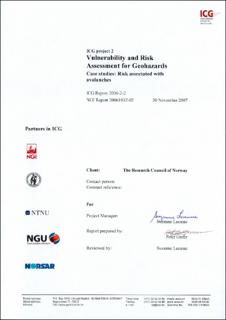ICG project 2: Vulnerability and risk assessment for geohazards. Case studies: Risk associated with avalanches.
Research report
Permanent lenke
https://hdl.handle.net/11250/3082079Utgivelsesdato
2007-11-30Metadata
Vis full innførselSamlinger
- NGI report [198]
Sammendrag
This report documents an approach for the probabilistic risk assessment for avalanches. It presents two case studies:
1) A case regarding the risk to a building in an avalanche path:
2) A study concerningtherisk to traffic on a major mountain road.
Estimates of hazard, vulnerability and risk are given. The methodology adopted in the present case study refers to the general risk terminology from ICG (2004).
The report summarizes vulnerability values due to avalanche impacts retrieved from the literature.
In the first case study of a farm in an avalanche path, a combination of empirical meteorological data (extreme snow precipitation data), a slide release model, and a runout model employing Monte-Carlo simulations in both cases are used to quantify hazard and risk.
The second case study considers traffic along a road stretch in avalanche-prone area and reveals high risk to individuals. A comparison between the risk with and without å mitigation measure (i.e. with and without a protection gallery) shows the beneficial effect of the mitigation measure. However, waiting traffic increase significantly the risk, which implies that after an avalanche event immediate action is needed to avoid waiting traffic.
The case studies illustrate the methods, but do not claim to be generally valid. A main challenge for the proposed methodsis the choice of realistic distribution functions and their parameters. Not enough knowledge is available on this subject. To fill those gaps, expert judgment needs to be applied, more data should be gathered, and more research should be carried out. Deterministic models support the probabilistic approach for the choice of parameters.

